Abstract
6-n-propylthiouracil (PTU) administered to male Sprague-Dawley rats maintained on 2 and 5 μg L-thyroxine (T4)/100 g body weight resulted in a marked reduction in the rate of conversion of L-thyroxine to L-triiodothyronine (T3). These effects could not be ascribed to induced hypothyroidism since the group maintained on 5 μg T4/day had normal levels of liver mitochondrial alpha glycerophosphate dehydrogenase. In confirmation of previous studies, PTU also reduced the fractional rate of deiodination of T3. These observations provide a possible explanation of the many published observations indicating that PTU antagonizes the tissue effects of T4 but not of T3. The data suggest that monodeiodination of T4 but not of T3 is essential before hormonal effects can be manifested at the cellular level.
Full text
PDF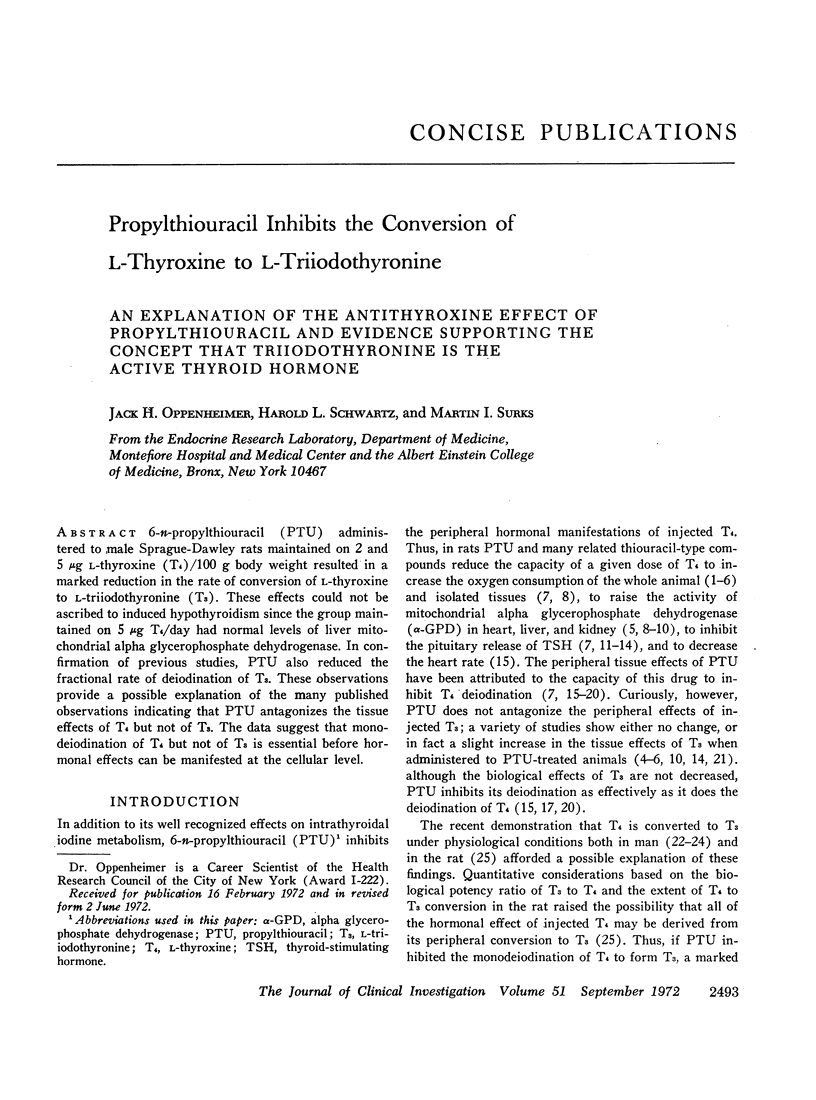
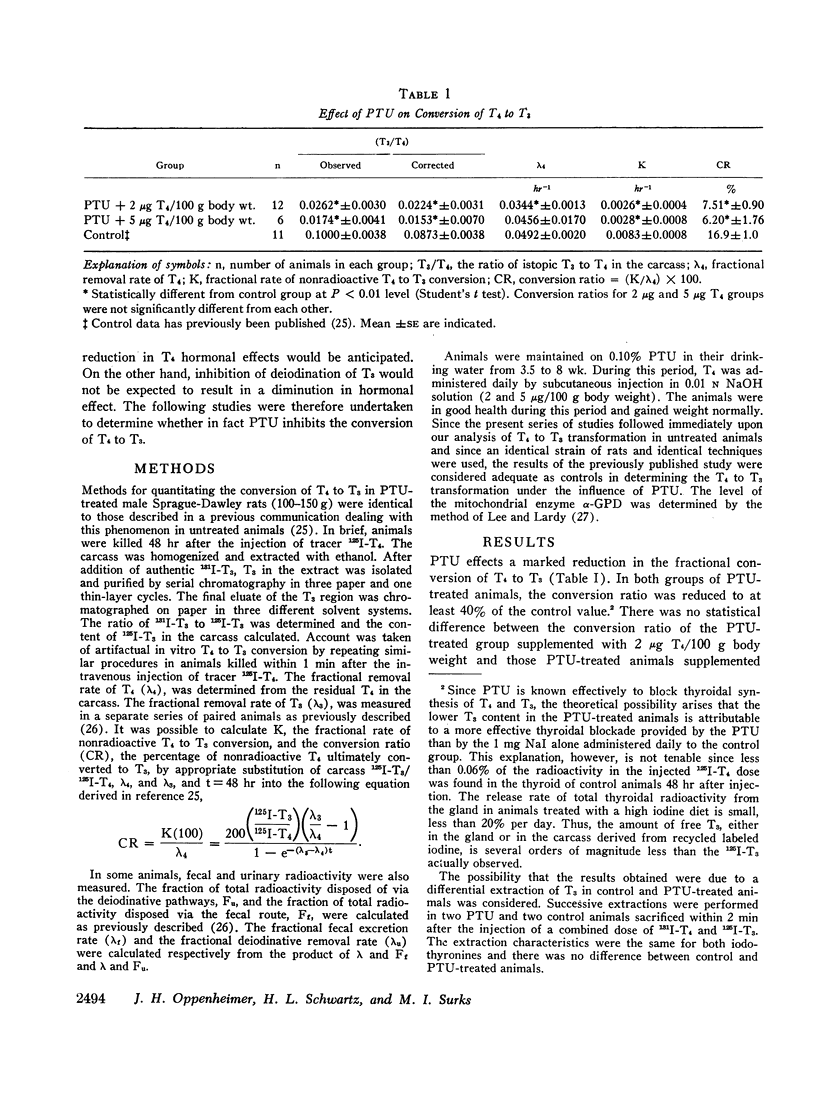
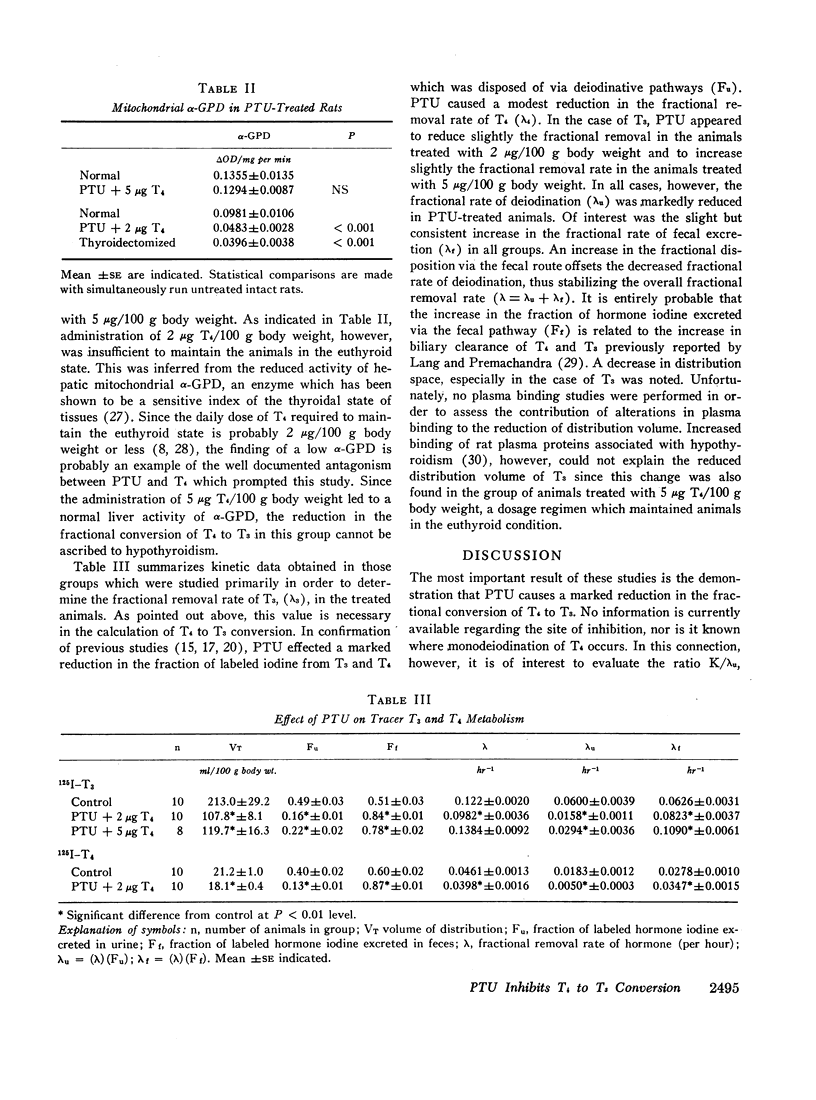
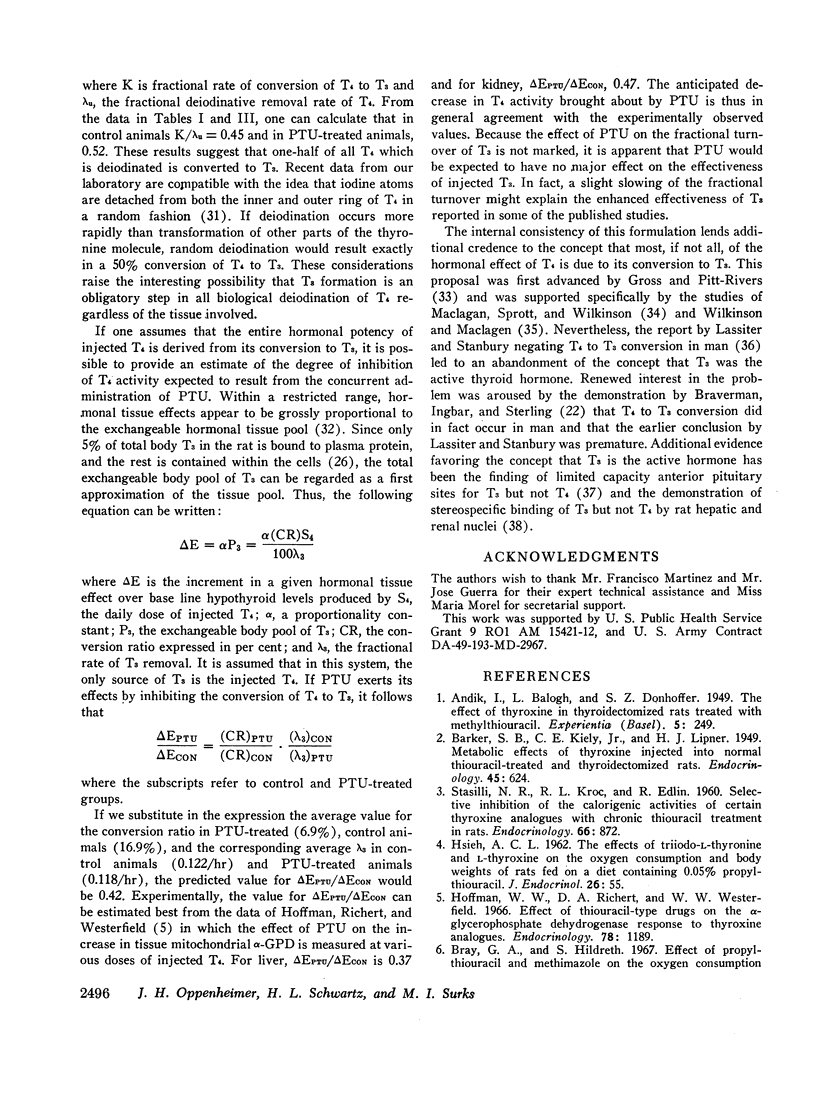
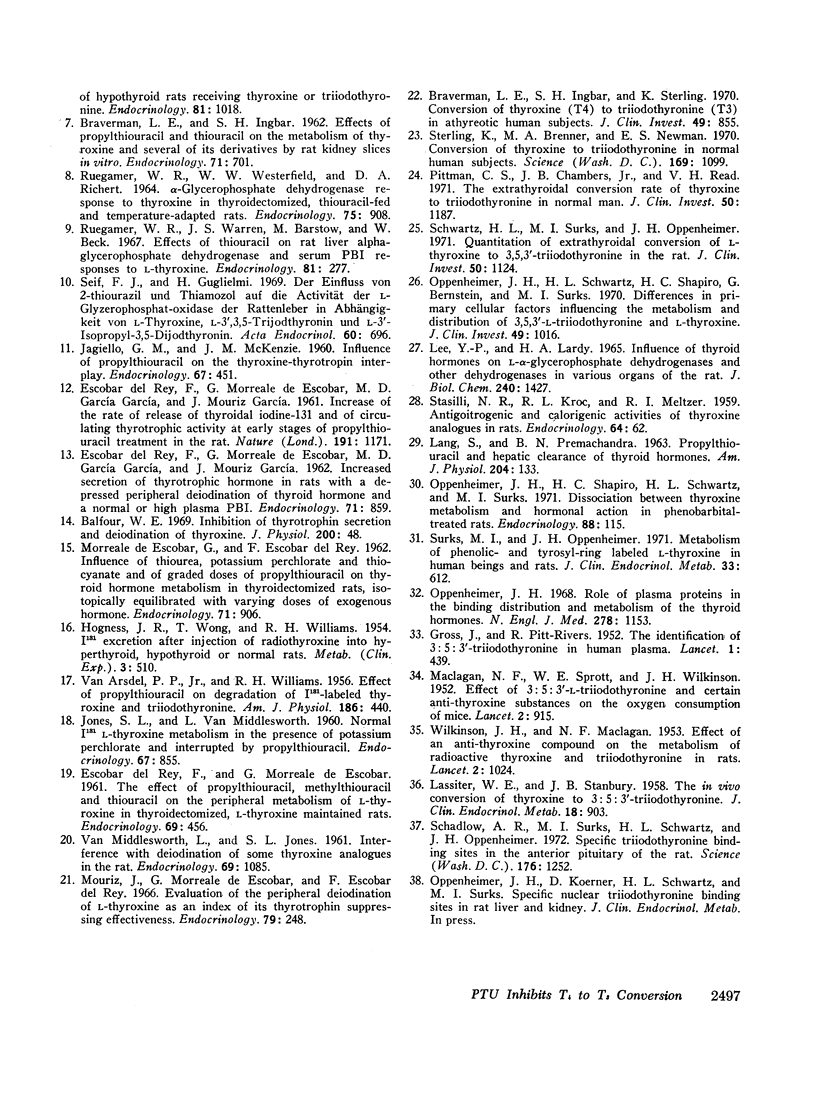
Selected References
These references are in PubMed. This may not be the complete list of references from this article.
- BARKER S. B., KIELY C. E., Jr, LIPNER H. J. Metabolic effects of thyroxine injected into normal, thiouracil-treated and thyroidectomized rats. Endocrinology. 1949 Dec;45(6):624–627. doi: 10.1210/endo-45-6-624. [DOI] [PubMed] [Google Scholar]
- BRAVERMAN L. E., INGBAR S. H. Effects of propylthiouracil and thiouracil on the metabolism of thyroxine and several of its derivatives by rat kidney slices in vitro. Endocrinology. 1962 Nov;71:701–712. doi: 10.1210/endo-71-5-701. [DOI] [PubMed] [Google Scholar]
- Braverman L. E., Ingbar S. H., Sterling K. Conversion of thyroxine (T4) to triiodothyronine (T3) in athyreotic human subjects. J Clin Invest. 1970 May;49(5):855–864. doi: 10.1172/JCI106304. [DOI] [PMC free article] [PubMed] [Google Scholar]
- Bray G. A., Hildreth S. Effect of propylthiouracil and methimazole on the oxygen comsumption of hypothyroid rats receiving thyroxine or triiodothyronine. Endocrinology. 1967 Nov;81(5):1018–1020. doi: 10.1210/endo-81-5-1018. [DOI] [PubMed] [Google Scholar]
- ESCOBAR DEL REY F., MORREALE DE ESCOBAR G., GARCIA GARCIA M. D., MOURIZ GARCIA J. Increase of the rate of release of thyroidal iodine-131 and of circulating thyrotrophic activity at early stages of prophylthiouracil treatment in the rat. Nature. 1961 Sep 16;191:1171–1173. doi: 10.1038/1911171a0. [DOI] [PubMed] [Google Scholar]
- ESCOBAR DEL REY F., MORREALE DE ESCOBAR G. The effect of propylthiouracil, methylthiouracil and thiouracil on the peripheral metabolism of 1-thyroxine in thyroidectomized, 1-thyroxine maintained rats. Endocrinology. 1961 Sep;69:456–465. doi: 10.1210/endo-69-3-456. [DOI] [PubMed] [Google Scholar]
- GROSS J., PITT-RIVERS R. The identification of 3:5:3'-L-triiodothyronine in human plasma. Lancet. 1952 Mar 1;1(6705):439–441. doi: 10.1016/s0140-6736(52)91952-1. [DOI] [PubMed] [Google Scholar]
- HOGNESS J. R., WONG T., WILLIAMS R. H. I131 excretion after injection of radiothyroxine into hyperthyroid, hypothyroid or normal rats. Metabolism. 1954 Nov;3(6):510–517. [PubMed] [Google Scholar]
- HSIEH A. C. The effects of triiodo-L-thyronine and L-thyroxine on the oxygen consumption and body weights of rats fed on a diet containing 0.05 percent propylthiouracil. J Endocrinol. 1963 Mar;26:55–63. doi: 10.1677/joe.0.0260055. [DOI] [PubMed] [Google Scholar]
- Hoffman W. W., Richert D. A., Westerfeld W. W. Effect of thiouracil-type drugs on the alpha-glycerophosphate dehydrogenase response to thyroxine analogs. Endocrinology. 1966 Jun;78(6):1189–1197. doi: 10.1210/endo-78-6-1189. [DOI] [PubMed] [Google Scholar]
- JAGIELLO G. M., McKENZIE J. M. Influence of propylthiouracil on the thyroxine-thyrotropin interplay. Endocrinology. 1960 Oct;67:451–456. doi: 10.1210/endo-67-4-451. [DOI] [PubMed] [Google Scholar]
- JONES S. L., VAN MIDDLESWORTH L. Normal I-131 L-thyroxine metabolism in the presence of potassium perchlorate and interrupted by propylthiouracil. Endocrinology. 1960 Dec;67:855–861. doi: 10.1210/endo-67-6-855. [DOI] [PubMed] [Google Scholar]
- LANG S., PREMACHANDRA B. N. Propylthiouracil and hepatic clearance of thyroid hormones. Am J Physiol. 1963 Jan;204:133–136. doi: 10.1152/ajplegacy.1963.204.1.133. [DOI] [PubMed] [Google Scholar]
- LASSITER W. R., STANBURY J. B. The in vivo conversion of thyroxine to 3:5:3'triiodothyronine. J Clin Endocrinol Metab. 1958 Aug;18(8):903–906. doi: 10.1210/jcem-18-8-903. [DOI] [PubMed] [Google Scholar]
- LEE Y. P., LARDY H. A. INFLUENCE OF THYROID HORMONES ON L-ALPHA-GLYCEROPHOSPHATE DEHYDROGENASES AND OTHER DEHYDROGENASES IN VARIOUS ORGANS OF THE RAT. J Biol Chem. 1965 Mar;240:1427–1436. [PubMed] [Google Scholar]
- MACLAGAN N. F., SPROTT W. E., WILKINSON J. H. Effect of 3:5:3-L-triiodothyronine and certain anti-thyroxine substances on the oxygen consumption of mice. Lancet. 1952 Nov 8;2(6741):915–916. doi: 10.1016/s0140-6736(52)91279-8. [DOI] [PubMed] [Google Scholar]
- Mouriz J., Morreale de Escobar G., Escobar del Rey F. Evaluation of the peripheral deiodination of L-thyroxine as an index of its thyrotrophin suppressing effectiveness. Endocrinology. 1966 Aug;79(2):248–260. doi: 10.1210/endo-79-2-248. [DOI] [PubMed] [Google Scholar]
- Oppenheimer J. H. Role of plasma proteins in the binding, distribution and metabolism of the thyroid hormones. N Engl J Med. 1968 May 23;278(21):1153–1162. doi: 10.1056/NEJM196805232782107. [DOI] [PubMed] [Google Scholar]
- Oppenheimer J. H., Schwartz H. L., Shapiro H. C., Bernstein G., Surks M. I. Differences in primary cellular factors influencing the metabolism and distribution of 3,5,3'-L-triiodothyronine and L-thyroxine. J Clin Invest. 1970 May;49(5):1016–1024. doi: 10.1172/JCI106301. [DOI] [PMC free article] [PubMed] [Google Scholar]
- Oppenheimer J. H., Shapiro H. C., Schwartz H. L., Surks M. I. Dissociation between thyroxine metabolism and hormonal action in phenobarbital-treated rats. Endocrinology. 1971 Jan;88(1):115–119. doi: 10.1210/endo-88-1-115. [DOI] [PubMed] [Google Scholar]
- Pittman C. S., Chambers J. B., Jr, Read V. H. The extrathyroidal conversion rate of thyroxine to triiodothyronine in normal man. J Clin Invest. 1971 Jun;50(6):1187–1196. doi: 10.1172/JCI106596. [DOI] [PMC free article] [PubMed] [Google Scholar]
- RUEGAMER W. R., WESTERFELD W. W., RICHERT D. A. ALPHA-GLYCEROPHOSPHATE DEHYDROGENASE RESPONSE TO THYROXINE IN THYROIDECTOMIZED, THIOURACIL-FED AND TEMPERATURE-ADAPTED RATS. Endocrinology. 1964 Dec;75:908–916. doi: 10.1210/endo-75-6-908. [DOI] [PubMed] [Google Scholar]
- Ruegamer W. R., Warren J. S., Barstow M., Beck W. Effects of thiouracil on rat liver alpha-glycerophosphate dehydrogenase and serum PBI responses to L-thyroxine. Endocrinology. 1967 Aug;81(2):277–282. doi: 10.1210/endo-81-2-277. [DOI] [PubMed] [Google Scholar]
- STASILLI N. R., KROC R. L., EDLIN R. Selective inhibition of the calorigenic activities of certain thyroxine analogues with chronic thiouracil treatment in rats. Endocrinology. 1960 Jun;66:872–885. doi: 10.1210/endo-66-6-872. [DOI] [PubMed] [Google Scholar]
- STASILLI N. R., KROC R. L., MELTZER R. I. Antigoitrogenic and calorigenic activities of thyroxine analogues in rats. Endocrinology. 1959 Jan;64(1):62–82. doi: 10.1210/endo-64-1-62. [DOI] [PubMed] [Google Scholar]
- Schadlow A. R., Surks M. I., Schwartz H. L., Oppenheimer J. H. Specific triiodothyronine binding sites in the anterior pituitary of the rat. Science. 1972 Jun 16;176(4040):1252–1254. doi: 10.1126/science.176.4040.1252. [DOI] [PubMed] [Google Scholar]
- Schwartz H. L., Surks M. I., Oppenheimer J. H. Quantitation of extrathyroidal conversion of L-thyroxine to 3,5,3'-triiodo-L-thyronine in the rat. J Clin Invest. 1971 May;50(5):1124–1130. doi: 10.1172/JCI106584. [DOI] [PMC free article] [PubMed] [Google Scholar]
- Seif F. J., Guglielmi H. Der Einfluss von 2-Thiourazil und Thiamazol auf die Aktivität der L-alpha-Glyzerophosphat-oxidase der Rattenleber in Abhängigkeit von L-Thyroxin, L-3',3,5-Trijodthyronin und L-3'-Isopropyl-3,5-dijodthyronin. Acta Endocrinol (Copenh) 1969 Apr;60(4):696–704. [PubMed] [Google Scholar]
- Sterling K., Brenner M. A., Newman E. S. Conversion of thyroxine to triiodothyronine in normal human subjects. Science. 1970 Sep 11;169(3950):1099–1100. doi: 10.1126/science.169.3950.1099. [DOI] [PubMed] [Google Scholar]
- Surks M. I., Oppenheimer J. H. Metabolism of phenolic- and tyrosyl-ring labeled L-thyroxine in human beings and rats. J Clin Endocrinol Metab. 1971 Oct;33(4):612–618. doi: 10.1210/jcem-33-4-612. [DOI] [PubMed] [Google Scholar]
- VAN MIDDLESWORTH L., JONES S. L. Interference with deiodination of some thyroxine analogues in the rat. Endocrinology. 1961 Dec;69:1085–1087. doi: 10.1210/endo-69-6-1085. [DOI] [PubMed] [Google Scholar]
- VANARSDEL P. P., Jr, WILLIAMS R. H. Effect of propylthiouracil on degradation of I 131-labeled thyroxine and triiodothyronine. Am J Physiol. 1956 Sep;186(3):440–444. doi: 10.1152/ajplegacy.1956.186.3.440. [DOI] [PubMed] [Google Scholar]
- WILKINSON J. H., MACLAGAN N. F. Effect of an anti-thyroxine compound on the metabolism of radioactive thyroxine and triiodothyronine in rats. Lancet. 1953 Nov 14;265(6794):1024–1025. doi: 10.1016/s0140-6736(53)91312-9. [DOI] [PubMed] [Google Scholar]


